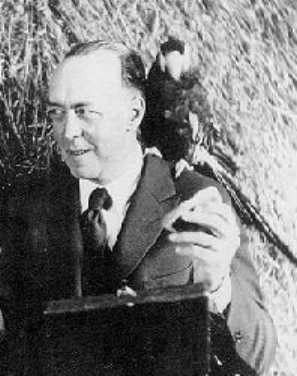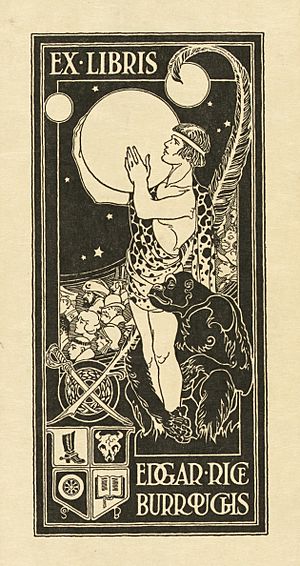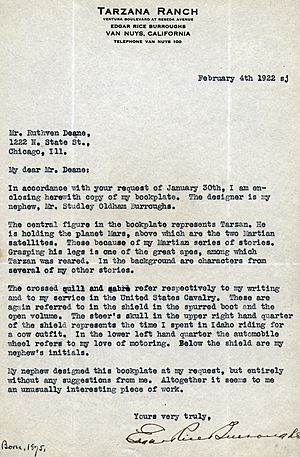Edgar Rice Burroughs facts for kids
Quick facts for kids
Edgar Rice Burroughs
|
|
|---|---|
 |
|
| Born | September 1, 1875 Chicago, Illinois, U.S. |
| Died | March 19, 1950 (aged 74) Encino, California, U.S. |
| Resting place | Tarzana, California, U.S. |
| Occupation | Novelist |
| Period | 1911–1950 |
| Genre | Adventure, fantasy, lost world, sword and planet, planetary romance, soft science fiction, western |
| Notable works |
|
| Notable awards | Inkpot Award (1975) |
| Spouse | Emma Centennia Hulbert (1900–1934) (divorced) Florence Gilbert (1935–1941) (divorced) |
| Children | Joan Burroughs Pierce, Hulbert Burroughs, John Coleman Burroughs |
| Relatives | James Pierce (son-in-law) |
| Signature | |
Edgar Rice Burroughs (September 1, 1875 – March 19, 1950) was an American writer, best known for his prolific output in the adventure, science fiction, and fantasy genres. Best-known for creating the characters Tarzan and John Carter, he also wrote the Pellucidar series, the Amtor series, and the Caspak trilogy.
Tarzan was immediately popular, and Burroughs capitalized on it in every way possible, including a syndicated Tarzan comic strip, movies, and merchandise. Tarzan remains one of the most successful fictional characters to this day and is a cultural icon. Burroughs's California ranch is now the center of the Tarzana neighborhood in Los Angeles, named after the character. Burroughs was an explicit supporter of eugenics and scientific racism in both his fiction and nonfiction; Tarzan was meant to reflect these concepts.
Contents
Biography
Early life and family
Burroughs was born on September 1, 1875, in Chicago (he later lived for many years in the suburb of Oak Park), the fourth son of Major George Tyler Burroughs (1833–1913), a businessman and Civil War veteran, and his wife, Mary Evaline (Zieger) Burroughs (1840–1920). His middle name is from his paternal grandmother, Mary Coleman Rice Burroughs (1802–1889). He was of almost entirely English ancestry, with a family line that had been in North America since the Colonial era.
Through his Rice grandmother, Burroughs was descended from settler Edmund Rice, one of the English Puritans who moved to Massachusetts Bay Colony in the early 17th century. He once remarked, "I can trace my ancestry back to Deacon Edmund Rice." The Burroughs side of the family was also of English origin and also emigrated to Massachusetts around the same time. Many of his ancestors fought in the American Revolution. Some of his ancestors settled in Virginia during the colonial period, and Burroughs often emphasized his connection with that side of his family, seeing it as romantic and warlike. As close cousins he had seven signatories of the U.S. Declaration of Independence, including his third cousin, four times removed, 2nd President of the United States John Adams.
Burroughs was educated at a number of local schools. He then attended Phillips Academy, in Andover, Massachusetts, and then the Michigan Military Academy. Graduating in 1895, and failing the entrance exam for the United States Military Academy at West Point, he became an enlisted soldier with the 7th U.S. Cavalry in Fort Grant, Arizona Territory. After being diagnosed with a heart problem and thus ineligible to serve, he was discharged in 1897.


After his discharge Burroughs worked at a number of different jobs. During the Chicago influenza epidemic of 1891, he spent half a year at his brother's ranch on the Raft River in Idaho, as a cowboy, drifted somewhat afterward, then worked at his father's Chicago battery factory in 1899, marrying his childhood sweetheart, Emma Hulbert (1876–1944), in January 1900.
In 1903, Burroughs joined his brothers, Yale graduates George and Harry, who were, by then, prominent Pocatello area ranchers in southern Idaho, and partners in the Sweetser-Burroughs Mining Company, where he took on managing their ill-fated Snake River gold dredge, a classic bucket-line dredge. The Burroughs brothers were also the sixth cousins, once removed, of famed miner Kate Rice who, in 1914, became the first female prospector in the Canadian North. Journalist and publisher C. Allen Thorndike Rice was also his third cousin.
When the new mine proved unsuccessful, the brothers secured for Burroughs a position with the Oregon Short Line Railroad in Salt Lake City. Burroughs resigned from the railroad in October 1904.
Later life
By 1911, after seven years of low wages as a pencil-sharpener wholesaler, Burroughs began to write fiction. By this time, Emma and he had two children, Joan (1908–1972), and Hulbert (1909–1991). During this period, he had copious spare time and began reading pulp-fiction magazines.
In 1913, Burroughs and Emma had their third and last child, John Coleman Burroughs (1913–1979), later known for his illustrations of his father's books.
In the 1920s, Burroughs became a pilot, purchased a Security Airster S-1, and encouraged his family to learn to fly.
Daughter Joan married Tarzan film actor, James Pierce, starring with her husband, as the voice of Jane, during 1932–1934 for the Tarzan radio series. The pair were wed for more than forty years, until her death in 1972.
Burroughs divorced Emma in 1934 and, in 1935, married the former actress Florence Gilbert Dearholt, who was the former wife of his friend (who was then himself remarrying), Ashton Dearholt, with whom he had co-founded Burroughs-Tarzan Enterprises while filming The New Adventures of Tarzan. Burroughs adopted the Dearholts' two children. He and Florence divorced in 1942.
Burroughs was in his late 60s and was in Honolulu at the time of the Japanese attack on Pearl Harbor. Despite his age, he applied for and received permission to become a war correspondent, becoming one of the oldest U.S. war correspondents during World War II. This period of his life is mentioned in William Brinkley's bestselling novel Don't Go Near the Water.
Death
After the war ended, Burroughs moved back to Encino, California, where after many health problems, he died of a heart attack on March 19, 1950, having written almost 80 novels. He is buried in Tarzana, California, US.
At the time of his death he was believed to have been the writer who had made the most from films, earning over $2 million in royalties from 27 Tarzan pictures.
The Science Fiction Hall of Fame inducted Burroughs in 2003.
Literary career
Aiming his work at the pulps—under the name "Norman Bean" to protect his reputation—Burroughs had his first story, Under the Moons of Mars, serialized by Frank Munsey in the February to July 1912 issues of The All-Story. Under the Moons of Mars inaugurated the Barsoom series and earned Burroughs US$400 ($11,922 today). It was first published as a book by A. C. McClurg of Chicago in 1917, entitled A Princess of Mars, after three Barsoom sequels had appeared as serials and McClurg had published the first four serial Tarzan novels as books.
Burroughs soon took up writing full-time, and by the time the run of Under the Moons of Mars had finished, he had completed two novels, including Tarzan of the Apes, published from October 1912 and one of his most successful series.
Burroughs also wrote popular science fiction and fantasy stories involving adventurers from Earth transported to various planets (notably Barsoom, Burroughs's fictional name for Mars, and Amtor, his fictional name for Venus), lost islands (Caspak), and into the interior of the Hollow Earth in his Pellucidar stories. He also wrote Westerns and historical romances. Besides those published in All-Story, many of his stories were published in The Argosy magazine.
Tarzan was a cultural sensation when introduced. Burroughs was determined to capitalize on Tarzan's popularity in every way possible. He planned to exploit Tarzan through several different media including a syndicated Tarzan comic strip, movies, and merchandise. Experts in the field advised against this course of action, stating that the different media would just end up competing against each other. Burroughs went ahead, however, and proved the experts wrong – the public wanted Tarzan in whatever fashion he was offered. Tarzan remains one of the most successful fictional characters to this day and is a cultural icon.
In either 1915 or 1919, Burroughs purchased a large ranch north of Los Angeles, California, which he named "Tarzana". The citizens of the community that sprang up around the ranch voted to adopt that name when their community, Tarzana, California, was formed in 1927. Also, the unincorporated community of Tarzan, Texas, was formally named in 1927 when the US Postal Service accepted the name, reputedly coming from the popularity of the first (silent) Tarzan of the Apes film, starring Elmo Lincoln, and an early "Tarzan" comic strip.
In 1923, Burroughs set up his own company, Edgar Rice Burroughs, Inc., and began printing his own books through the 1930s.
Selected works
Barsoom series
- A Princess of Mars (1912)
- The Gods of Mars (1913)
- The Warlord of Mars (1914)
- Thuvia, Maid of Mars (1916)
- The Chessmen of Mars (1922)
- The Master Mind of Mars (1927)
- A Fighting Man of Mars (1930)
- Swords of Mars (1934)
- Synthetic Men of Mars (1939)
- Llana of Gathol (1941)
- John Carter of Mars (1964, two stories from 1940 and 1943)
Tarzan series
- Tarzan of the Apes (1912)
- The Return of Tarzan (1913)
- The Beasts of Tarzan (1914)
- The Son of Tarzan (1915)
- Tarzan and the Jewels of Opar (1916)
- Jungle Tales of Tarzan (stories 1916–1917)
- Tarzan the Untamed (1919)
- Tarzan the Terrible (1921)
- Tarzan and the Golden Lion (1922)
- Tarzan and the Ant Men (1924)
- Tarzan, Lord of the Jungle (1927)
- Tarzan and the Lost Empire (1928)
- Tarzan at the Earth's Core (1929)
- Tarzan the Invincible (1930)
- Tarzan Triumphant (1931)
- Tarzan and the City of Gold (1932)
- Tarzan and the Lion Man (1933)
- Tarzan and the Leopard Men (1932)
- Tarzan's Quest (1935)
- Tarzan the Magnificent (1936)
- Tarzan and the Forbidden City (1938)
- Tarzan and the Foreign Legion (1947, written in 1944)
- Tarzan and the Tarzan Twins (1963, collects 1927 and 1936 children's books)
- Tarzan and the Madman (1964, written in 1940)
- Tarzan and the Castaways (1965, stories from 1940 to 1941)
- Tarzan: The Lost Adventure (1995, rewritten version of 1946 fragment, completed by Joe R. Lansdale)
Pellucidar series
- At the Earth's Core (1914)
- Pellucidar (1915)
- Tanar of Pellucidar (1929)
- Tarzan at the Earth's Core (1929)
- Back to the Stone Age (1937)
- Land of Terror (1944, written in 1939)
- Savage Pellucidar (1963, stories from 1942)
Venus series
- Pirates of Venus (1932)
- Lost on Venus (1933)
- Carson of Venus (1938)
- Escape on Venus (1946, stories from 1941 to 1942)
- The Wizard of Venus (1970, written in 1941)
Caspak series
- The Land That Time Forgot (1918)
- The People That Time Forgot (1918)
- Out of Time's Abyss (1918)
Moon series
- Part I: The Moon Maid (1923, serialized in Argosy, May 5 – June 2, 1923)
- Part II: The Moon Men (1925, serialized in Argosy, February 21 – March 14, 1925)
- Part III: The Red Hawk (1925 serialized in Argosy, September 5–19, 1925)
These three texts have been published by various houses in one or two volumes. Adding to the confusion, some editions have the original (significantly longer) introduction to Part I from the first publication as a magazine serial, and others have the shorter version from the first book publication, which included all three parts under the title The Moon Maid.
Mucker series
- The Mucker (1914)
- The Return of the Mucker (1916)
- The Oakdale Affair (1918)
Other science fiction
- The Monster Men (1913)
- The Lost Continent (1916; a.k.a. Beyond Thirty)
- The Resurrection of Jimber-Jaw (1937)
- Beyond the Farthest Star (1942)
Jungle adventure novels
- The Cave Girl (1913, revised 1917)
- The Eternal Lover (1914, rev. 1915; A.K.A. The Eternal Savage)
- The Man-Eater (1915)
- The Lad and the Lion (1917)
- Jungle Girl (1931; A.K.A. The Land of Hidden Men)
Western novels
- The Bandit of Hell's Bend (1924)
- The War Chief (1927)
- Apache Devil (1933)
- The Deputy Sheriff of Comanche County (1940)
Historical novels
- The Outlaw of Torn (1914)
- I am a Barbarian (1967; written in 1941)
Other works
- Minidoka: 937th Earl of One Mile Series M (1998; written in 1903)
- The Mad King (1914, rev. 1915)
- The Girl from Farris's (1916)
- The Rider (1918)
- The Efficiency Expert (1921)
- The Girl from Hollywood (1922)
- Marcia of the Doorstep (1924)
- You Lucky Girl! (1927)
- Pirate Blood (1970; written in 1932)
- Forgotten Tales of Love and Murder (2001; stories from 1910 to 1944)
- Brother Men (2005; nonfiction)
See also
 In Spanish: Edgar Rice Burroughs para niños
In Spanish: Edgar Rice Burroughs para niños
- Edgar Rice Burroughs, Inc.
- Mars in fiction
- Otis Adelbert Kline
- Sword and planet

